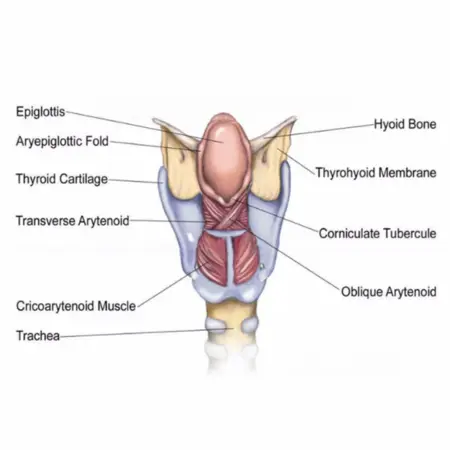Imagine your voice as a musical instrument inside your body. Just like a guitar has strings, your throat has vocal cords.
These tiny but mighty parts work hard every time you make a sound. They’re the hidden heroes that bring your words to life!
This article is all about vocal cord anatomy. We’ll learn about what they look like, how they work, and why they’re so important.
Key Takeaways
– Vocal cords are inside a part of your throat called the larynx, which is about the size of a small strawberry.
– Vocal cords look like rubber bands. They are soft, flexible, and covered in a thin layer of moisture to keep them healthy.
– Vocal cords have layers. Each layer has different functions.
– Vocal cords vibrate fast, up to 1,000 times per second, creating the sound of your voice when you talk or sing.
– When you swallow, they close tightly to stop food and water from going into your lungs.
– When you’re not talking, they open wide to let air in and out of your lungs.
– Vocal cord problems can affect your voice or even cause loss of voice.
Vocal Cord Anatomy: The Basics
Your vocal cords live inside a part of your throat called the larynx. The larynx is also known as your voice box. It’s located in the front of your neck, just below your chin.
If you’re an adult, your larynx is about 2 inches (5 centimeters) long. That’s about the size of a small strawberry.

The vocal cords sit right in the middle of the larynx. They’re like two tiny curtains that stretch across the inside of your voice box.
When you breathe, these curtains open wide to let air pass through. When you talk or sing, they come together and vibrate to make sounds.
1. What Do Vocal Cords Look Like?
Imagine two small, white rubber bands side by side. That’s kind of what your vocal cord anatomy is. They’re soft and flexible, just like rubber bands.
In adults, vocal cords are usually between 0.5 to 1 inch (12-24 millimeters) long. That’s about the length of a paper clip.
The vocal cords are made up of special tissues that can stretch and vibrate. They’re covered with a thin, clear mucus that keeps them moist and healthy.
This moisture is important because dry vocal cords can’t make sounds as well.
2. The Layers Of Your Vocal Cords
Your vocal cord anatomy might look simple, but they’re made up of several layers. There are five main layers:
1. `The outer layer: This is a thin, protective covering.
2. The superficial layer: It’s soft and jiggly, like jelly.
3. The intermediate layer: This layer is a bit firmer.
4. The deep layer: It’s even more solid than the intermediate layer.
5. The muscle layer: This is the strongest part that helps move the vocal cords.
These layers work together to help your vocal cords stretch, vibrate, and make all kinds of sounds.
The soft outer layers help your voice sound smooth, while the stronger inner layers give it power.
Fun Fact: Did you know that your vocal cords vibrate super fast when you talk? They can move back and forth 100 to 1,000 times per second! That’s faster than a hummingbird’s wings.
How Vocal Cords Are Positioned
Imagine two small, white bands stretching across your throat. That’s what vocal cord anatomy looks like. They sit inside your voice box, also called the larynx.
These bands are shaped like a “V” when they’re open, and they come together to form a thin line when closed.
1. Cartilages And Muscles Around The Vocal Cords
Your vocal cords don’t work alone. They’re surrounded by special structures that help them move and make sounds:
– Cartilages: These are like flexible bones. The main ones are:
– Thyroid cartilage: This is the biggest one and forms your Adam’s apple.
– Cricoid cartilage: It’s shaped like a ring at the bottom of your voice box.
– Arytenoid cartilages: These small, pyramid-shaped pieces help move your vocal cords.

Tiny muscles connect to the cartilage and help your vocal cords stretch, relax, and vibrate. Some important ones are:
– Thyroarytenoid muscles: These help shorten and thicken your vocal cords.
– Cricothyroid muscles: They help make your voice higher.
2. How Vocal Cords Connect To Other Throat Parts
Your vocal cords are part of a bigger team in your throat:
A. Above The vocal cords
The epiglottis: This flap of tissue covers your voice box when you swallow to stop food from going down the wrong way.
False vocal cords: These sit just above your real vocal cords and help protect them.
B. Below The Vocal Cords
The trachea (windpipe): This is the tube that carries air to and from your lungs.
C. Around The Vocal Cords
The pharynx (throat): This is the passage behind your mouth and nose.
The esophagus: This tube is behind your voice box and carries food to your stomach.
Cool fact: When you breathe, your vocal cords open wide to let air pass. But when you talk, they come close together and vibrate as air moves past them.
Vocal Cords Function: More Than Just Sound
Your vocal cords are like two special rubber bands in your throat. When you speak or sing, they vibrate fast. This vibration creates the sound of your voice.
Your vocal cords can vibrate up to 1000 times per second when you’re singing high notes.
Here’s how it works:
– Air from your lungs pushes against your vocal cords.
– Your vocal cords close and open very quickly.
– This makes a buzzing sound.
– The sound travels up through your mouth and nose.
– Your tongue, lips, and teeth shape the sound into words.

1. Protecting Your Airway
Your vocal cords are also like superheroes that protect you when you eat and drink. When you swallow, they close tightly.
This stops food and water from going into your lungs. Fun fact: You swallow about 600 times a day.
2. Helping You Breathe
Believe it or not, your vocal cords help you breathe too! When you’re not talking, they stay open. This lets air flow easily in and out of your lungs.
When you exercise, your vocal cords open even wider. This helps you get more air when you need it.
Did you know? Adults usually breathe 12 to 20 times per minute when resting.
Common Vocal Cord Problems And Their Impact
Our voices are an important part of who we are. But sometimes, our vocal cords can get damaged which affects how we speak.
Let’s look at some common vocal cord issues and how they can impact our lives.
1. Nodules And Polyps
Vocal cord nodules and polyps are like small bumps that grow on the vocal cords. They’re often caused by overusing or straining your voice.
Nodules are hard, callus-like growths that usually appear in pairs, one on each vocal cord.
Polyps are softer, and typically only grow on one vocal cord.
About 50% of people with voice problems have nodules or polyps. These growths can make your voice sound:
– Hoarse
– Breathy
– Lower in pitch than usual
Singers might notice they can’t hit high notes like before. In fact, about 40-60% of professional singers will develop nodules or polyps at some point in their careers.
2. Vocal Cord Paralysis
Vocal cord paralysis happens when one or both vocal cords can’t move properly. This can be caused by nerve damage, surgery, or certain diseases.
Unilateral paralysis (one vocal cord) affects about 1 in 10,000 people.
Bilateral paralysis (both vocal cords) is less common, affecting about 1 in 100,000 people.

People with vocal cord paralysis might experience:
– A weak, breathy voice
– Trouble speaking loudly
– Difficulty swallowing
– Shortness of breath
In severe cases, bilateral vocal cord paralysis can make it hard to breathe. About 50% of people with this condition need a tracheostomy (a breathing tube in the neck) at some point.
3. Laryngitis & Inflammation
Laryngitis is when your vocal cords become swollen and irritated. It’s usually caused by a virus, but can also result from overusing your voice or irritants like smoke.
Acute laryngitis lasts less than 3 weeks and affects about 1 in 10 people each year.
Chronic laryngitis lasts more than 3 weeks and affects about 1 in 5 people at some point in their lives.
When you have laryngitis, you might notice:
– A hoarse or raspy voice
– Loss of voice
– A sore throat
– The need to clear your throat often
Most cases of acute laryngitis get better on their own within 1-2 weeks. However chronic laryngitis can last for months or even years if not treated.
These vocal cord problems can have a big impact on daily life. They can affect how we communicate at work, with friends, and at home.
For people who use their voices a lot in their jobs, these issues can even affect their careers.
Conclusion
Our vocal cord anatomy is amazing. They help us talk, sing, and even breathe! Let’s take a moment to think about how special they are.
These tiny folds in our throats do so much for us every day. They vibrate to make sounds when we speak.
They also protect us when we swallow food. And they help control our breathing too.
It’s important to understand vocal cord anatomy and take care of them.
We can do this by drinking lots of water, not yelling too much, and resting our voice when we feel tired.
Resources For Further Study
– “Everything to know about the larynx” by Medical News Today.
– “Influence of human vocal cord movements on airflow and resistance during eupnea” by S J England, D Bartlett Jr, J A Daubenspeck.
- How To Keep The Conversation Going: 12 Expert Tips That Work - December 26, 2024
- Master Speech And Debate: 5 Essential Tips For Success - December 16, 2024
- 11 Communication Quotes To Inspire & Improve Conversations - November 20, 2024

Leave a Reply